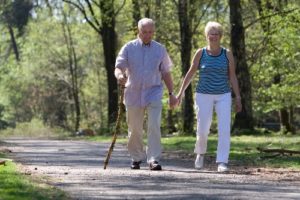 Walking strengthens your muscles – which helps shift pressure from joints and reduce pain – increases your balance and strength, and improves your overall health. It helps you attain and maintain a healthy weight, which in turn, lessens stress on joints and improves arthritis symptoms. If you have arthritis and do not exercise regularly, try walking. Walking is the best way to begin the transition from inactivity to activity. Physical activity helps to maintain both physical and mental health in patients with arthritis. Walking can help relieve arthritis pain, such as stiffness and swelling. Here are some of the advantages of walking…
Walking strengthens your muscles – which helps shift pressure from joints and reduce pain – increases your balance and strength, and improves your overall health. It helps you attain and maintain a healthy weight, which in turn, lessens stress on joints and improves arthritis symptoms. If you have arthritis and do not exercise regularly, try walking. Walking is the best way to begin the transition from inactivity to activity. Physical activity helps to maintain both physical and mental health in patients with arthritis. Walking can help relieve arthritis pain, such as stiffness and swelling. Here are some of the advantages of walking…
Walking…
Is Relatively Easy
You need no equipment. You have been doing it since you were about one year old. You do not need training or a class. Just jump right in and start yourself a walking program.
Is Free
You can start in a park and even stop and smell the roses. Or walk in your neighborhood and wave to your neighbors. If it is raining or or cold go to a mall and just look in the windows as you pass by. Walking releases natural pain killing endorphins to the body – one of the emotional benefits .
Uses Your Whole Body
It tones your leg and abdominal muscles – and even arm muscles if you pump them as you walk. This increases your range of motion, shifting the pressure and weight from your joints and muscles – which are meant to handle weight – helping to lessen arthritis pain. Almost all of the major muscle groups are needed to maintain motion, balance, and posture while walking.
Burns Calories
A brisk 30-minute walk burns 200 calories. Over time, calories burned can lead to pounds dropped. This can help you maintain a healthy weight.
Is a Mood Booster
Physical activity promotes the release of chemicals in the brain, which elevates mood. As you walk more and become more active, you will become more confident in your physical abilities. It slows mental decline. A study of 6,000 women, ages 65 and older, performed by researchers at the University of California, San Francisco, found that age-related memory decline was lower in those who walked more. The women walking 2.5 miles per day had a 17-percent decline in memory, as opposed to a 25-percent decline in women who walked less than a half-mile per week.
Getting Started With Your Walking Program
- 30 Minutes / 5 Days a Weeks – You should start with 30 minutes of exercise 5 days a week. Ideally you should aim for 150 minutes each week.
- Start Slow – Start slow and easy and increase the time and pace as you can. Try 10 minutes for your first walk. Do this on a regular basis say after dinner each evening. If you succeed with 10 minutes this week try 15 minutes the next week. The goal is to stay committed to your program. Start walking on a sunny day in your neighborhood and clock a 10 minute route that takes you to and from your home. Small victories can build confidence.
- Maybe Trekking Poles Will Help – If you have pain or weakness in a weight bearing joint such as your hip or knee, you may find trekking poles give the stability you need. Trekking poles, traditionally used in Nordic walking, are almost everywhere walkers walk today – and with good reason: Here’s the good news for people with arthritis: The poles used in Nordic walking help with balance and stability and can make walking easier while still providing a great workout. “For people with joint injuries in their lower bodies or lower back, trekking poles can help absorb some of the landing impact with each step
If you find walking too painful or difficult for you, there are ways you can be active. Just do simple stretching an strength-building exercises at home. Or try water therapy. Finally, a little muscle soreness after exercising is fine and will decrease as you become more active but if you have a severe pain or sudden sharp pain in any joints stop exercising right away.
For persistent pain that is interfering with your daily activities, see a rheumatologist to make the correct diagnosis and begin the proper treatment.
Contact Us (859-331-3100) For More Information to Request an Appointment
—
 About Tristate Arthritis and Rheumatology
About Tristate Arthritis and Rheumatology
Tristate Arthritis and Rheumatology is first and largest Rheumatology practice in the Northern Kentucky area. Founded by Dr. Arthur Kunath in 1986, our rheumatology practice now consists of six doctors who are board certified in both Internal Medicine and Rheumatology and a Physician Assistant. Patients see one doctor (except in emergencies), thereby assuring continuity of care and an individualized doctor-patient atmosphere giving the physician the ability to establish personalized and detailed relationships. Our doctors have received numerous awards, including being listed as “Top Doctors” in Cincinnati Magazine, receiving the Patient’s Choice Award, the Most Compassionate Doctor Award, and the American College of Rheumatology’s “My Doc Rocks” award.
>> Learn More


